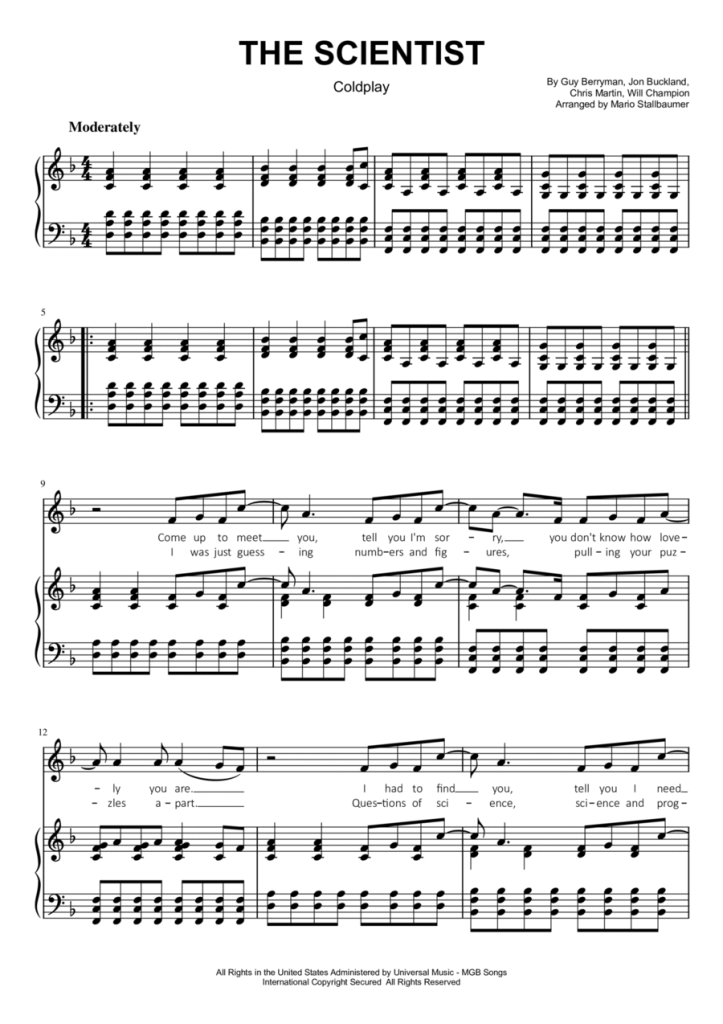Embark on a mesmerizing musical journey as we master Coldplay’s iconic ballad, ‘The Scientist,’ on the piano. Capturing the essence of Coldplay’s emotional depth and melodic prowess, this piano arrangement of ‘The Scientist’ is a challenging yet rewarding endeavor for aspiring pianists and Coldplay enthusiasts alike.
Join us on this musical odyssey as we unlock the secrets behind Coldplay’s ‘The Scientist’ on piano and immerse ourselves in the evocative beauty of this beloved song.
After some difficulty with the piano it’s Jonny Buckland and Chris Martin for the scientist tonight 🥹 #ColdplaySingapore night one 🇸🇬
pic.twitter.com/gKzVQCOpxQ— Coldplaying (@coldplaying) January 23, 2024
Introduction: Exploring the Beauty of Coldplay’s ‘The Scientist’ on Piano
Coldplay’s timeless classic, ‘The Scientist,’ is a beautiful piece that resonates with music lovers worldwide. Learning to play this emotional ballad on the piano can be an enriching experience for musicians of all levels. The yearning lyrics and the sad melody create a captivating atmosphere that captivates players and listeners.
Mastering the Chords
One key element in playing ‘The Scientist’ on the piano is mastering the chord progression that drives the song. The piano chords in this piece are crucial in conveying the raw emotion and vulnerability that defines Coldplay’s signature sound.
Focus on Dynamics and Expression
When learning to play ‘The Scientist’ on the piano, pay special attention to dynamics and expression. The song’s dynamics fluctuate between gentle, reflective, and self-reflective, and soaring sections, requiring the pianist to convey emotions through their playing.
- Experiment with crescendos and decrescendos to add depth to your interpretation.
- Use the sustain pedal to create a rich, resonant sound that enhances the piece’s overall mood.

Understanding the Chords and Melody
A solid understanding of the chords and melody is crucial when mastering Coldplay’s iconic song “The Scientist” on piano. The chord progression and melody in this piece play a significant role in creating the emotional impact that the song is known for.
The Chords
The chords in “The Scientist” set the song’s harmonic foundation. The progression revolves around emotional and poignant chords, enhancing the song’s melancholic vibe. Some common chords used in the song include Am, F, C, and G.
The Melody
The melody of “The Scientist” is hauntingly beautiful and is characterized by its simplicity yet emotional depth. Mastering the melody involves capturing the essence of the song’s longing and introspection. Practice playing the melody slowly and with feeling to capture the emotional impact.

Mastering the Timing and Dynamics
Mastering Coldplay’s “The Scientist” on piano requires a deep understanding of timing and dynamics to truly capture the emotional essence of the song. Attention to these aspects will elevate your performance and evoke the same raw feelings that Coldplay intended when creating this masterpiece.
Understanding Timing
Timing in music refers to the rhythm and tempo at which notes are played. In “The Scientist,” the piano plays a crucial role in setting the pace and mood of the song. Practice playing each note at the right moment to create a seamless flow that resonates with the listeners. Use a metronome to perfect your timing and ensure consistency throughout the piece. Consistent timing is critical to the essence of the song.
Mastering Dynamics
Dynamics in music denote the variations in volume and intensity. In “The Scientist,” dynamics play a significant role in conveying the song’s emotional journey. Practice playing with varying loudness and softness to add depth and emotion to your performance. Pay attention to crescendos and decrescendos to create a dynamic interpretation that moves the audience.
- Experiment with playing some sections softly to draw listeners in.
- Build up powerful sections with intense dynamics to create impact.
Adding Personal Touch and Interpretation
When mastering Coldplay’s iconic song ‘The Scientist’ on the piano, adding your personal touch and interpretation can elevate your performance. While staying true to the original melody and structure, allowing yourself to infuse the piece with your emotions and style can create a more unique and engaging rendition.
Expressing Emotions Through Dynamics
One way to add your personal touch is by adjusting the song’s dynamics. Experiment with softer or louder sections to convey different emotions effectively. For instance, emphasizing the gentle, melancholic parts with softer touches can evoke a sense of vulnerability and deep reflection.
Playing certain phrases with more intensity and power can bring out the raw emotions present in the music, capturing the listeners’ attention and creating a powerful impact.
Exploring Creative Interpretations
While staying within the framework of the original composition, feel free to explore creative interpretations. Consider adding embellishments, improvisations, or subtle variations in the tempo to make the piece your own.
By experimenting with different phrasing or rhythm patterns, you can showcase your musicality and individuality, making your rendition of ‘The Scientist’ on the piano stand out.
Tips for Perfecting Your Performance
Perfecting Coldplay’s ‘The Scientist’ on the piano requires practice, precision, and passion. Here are some tips to help you master this beautiful piece:
1. Start Slow and Gradually Increase Tempo
Begin by playing the song slowly to focus on the notes and finger placements. As you become more comfortable, gradually increase the speed while maintaining clarity and accuracy.
Remember, repetition is key to mastering any musical piece, so don’t rush learning.
2. Pay Attention to Dynamics and Emotions
Pay attention to the dynamics in the music to emulate Coldplay’s emotional delivery. Play gently to enhance the soft passages and bring out the intensity in the powerful sections.
Expressing the emotional depth of ‘The Scientist’ will elevate your performance and make it more captivating.
3. Practice with a Metronome
Use a metronome to improve your rhythm and timing while playing ‘The Scientist.’ Consistent practice with a metronome will help you develop a steady tempo and a more polished performance.
Frequently Asked Questions
- Is ‘The Scientist’ by Coldplay a popular song to learn on piano?
- Yes, ‘The Scientist’ is a very popular song to learn on the piano due to its beautiful melody and emotional impact.
- Is ‘The Scientist’ a difficult song to play on piano?
- While ‘The Scientist’ by Coldplay can be challenging for beginners, with practice and dedication, pianists of various skill levels can master it.
- Are there any specific techniques or tips for mastering ‘The Scientist’ on piano?
- Some tips for mastering ‘The Scientist’ on piano include practicing slowly, focusing on hand coordination, and paying attention to dynamics and expression in the music.
- Can I find online tutorials or resources to help me learn ‘The Scientist’ on piano?
- Yes, many online tutorials, sheet music, and resources are available to help you learn ‘The Scientist’ by Coldplay on piano. Platforms like YouTube and music learning websites can be valuable tools.
- What makes ‘The Scientist’ a popular choice for piano players?
- ‘The Scientist’ is popular among piano players because of its hauntingly beautiful melody, relatable lyrics, and overall emotional depth. It is a rewarding piece to learn and perform.
Unlocking the Melodies: A Harmonious Finale
Mastering Coldplay’s iconic piece “The Scientist” on the piano is not just about playing the right notes; it’s about capturing the emotion and depth behind each key. By delving into the intricate arrangement of this beloved song, pianists can convey a powerful narrative through their music.
Through this musical journey, we’ve explored the soul-stirring melodies and poignant lyrics that make “The Scientist” unforgettable. Remember, practice and patience are essential to genuinely mastering this masterpiece. So, keep playing, feeling, and connecting with your audience through the magic of Coldplay’s piano ballad.






